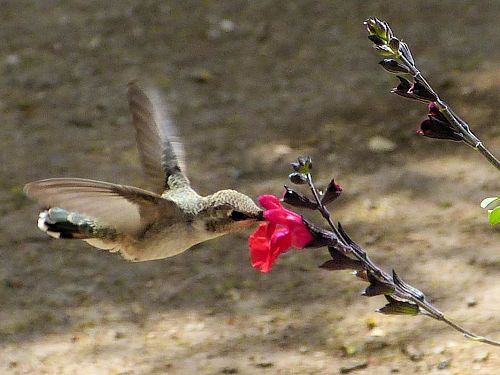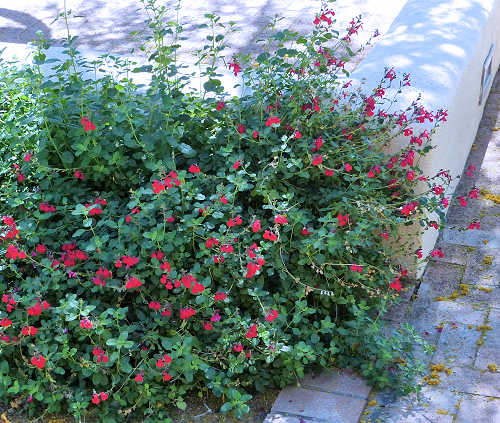Growing Salvia greggii:
Autumn Sage
Description
Form: Herbaceous stems growing from a woody base (subshrub)
Leaf retention: Evergreen to cold deciduous. Leaves are lost below 20°F (-6.7°C).
Growth rate: Moderate to rapid depending on temperature.
Mature Size: 1-3' (30-90cm) high and nearly as wide.
Flowers: Usually red, 1" (2.5cm) high, wide and long, with a distinct hump on top of its upper lip, a flared two-lobed lower lip at a right angle, fragrant and edible. Cultivars are available in many colors.
Bloom: Spring through fall, possibly all year in regions without freezes. This plant is a repeat bloomer.
Fruit: Up to four tiny seeds at the base of each dried flower.
Leaves: Oval, green, smooth edges, aromatic, edible.
Stems: Herbaceous from a woody base, growing woody with age.
Wildlife: The flowers attract hummingbirds and butterflies.
Toxic / Danger: No.
Origin: Texas and Northern Mexico.
Form: Herbaceous stems growing from a woody base (subshrub)
Leaf retention: Evergreen to cold deciduous. Leaves are lost below 20°F (-6.7°C).
Growth rate: Moderate to rapid depending on temperature.
Mature Size: 1-3' (30-90cm) high and nearly as wide.
Flowers: Usually red, 1" (2.5cm) high, wide and long, with a distinct hump on top of its upper lip, a flared two-lobed lower lip at a right angle, fragrant and edible. Cultivars are available in many colors.
Bloom: Spring through fall, possibly all year in regions without freezes. This plant is a repeat bloomer.
Fruit: Up to four tiny seeds at the base of each dried flower.
Leaves: Oval, green, smooth edges, aromatic, edible.
Stems: Herbaceous from a woody base, growing woody with age.
Wildlife: The flowers attract hummingbirds and butterflies.
Toxic / Danger: No.
Origin: Texas and Northern Mexico.
Cultivation and Uses
USDA hardiness zones: 7-11.
Heat tolerant: Yes.
Drought tolerant: Yes.
Sun: Part shade much of day, especially afternoon shade. This plant is slower to establish in full sun. Avoid reflected sun.
Soil: Well draining, organic content medium to low, pH 6.1-7.8 (slightly acidic to slightly alkaline). This plant should not be fertilized.
Water once established: Once or twice a month. In full sun, water is recommended once or twice a week in the hottest part of the year to produce the most flowers and provide enough nectar for hummingbirds.
Mulch: Do not mulch so the soil will dry quickly after watering or rain.
Prune: In mid winter, prune lightly to shape, or severely to rejuvenate. Prune every 4-6 months, by as much as one-half, to avoid a leggy appearance.
Litter: Low.
Propagation: Seed, cuttings, or layering. Cuttings have a 60% success rate.
Uses: Ornamental, wildlife attractor, culinary. The leaves, tasting either like mint or a cross between mint and sage, depending on cultivar and soil moisture, can be used fresh or dried for seasonings and teas. The edible flowers, used to add color to salads, have a lettuce-like taste. For other culinary sages, see Low Water Culinary Herbs.
USDA hardiness zones: 7-11.
Heat tolerant: Yes.
Drought tolerant: Yes.
Sun: Part shade much of day, especially afternoon shade. This plant is slower to establish in full sun. Avoid reflected sun.
Soil: Well draining, organic content medium to low, pH 6.1-7.8 (slightly acidic to slightly alkaline). This plant should not be fertilized.
Water once established: Once or twice a month. In full sun, water is recommended once or twice a week in the hottest part of the year to produce the most flowers and provide enough nectar for hummingbirds.
Mulch: Do not mulch so the soil will dry quickly after watering or rain.
Prune: In mid winter, prune lightly to shape, or severely to rejuvenate. Prune every 4-6 months, by as much as one-half, to avoid a leggy appearance.
Litter: Low.
Propagation: Seed, cuttings, or layering. Cuttings have a 60% success rate.
Uses: Ornamental, wildlife attractor, culinary. The leaves, tasting either like mint or a cross between mint and sage, depending on cultivar and soil moisture, can be used fresh or dried for seasonings and teas. The edible flowers, used to add color to salads, have a lettuce-like taste. For other culinary sages, see Low Water Culinary Herbs.
Comments
This plant is a member of the Mint family (Lamiaceae). Many cultivars are available. The butterfly in the picture is a Cloudless Sulphur.
Do you have additional information or a different experience for these plants that you would like to share? Email info@GardenOracle.com. All contributions are welcome and appreciated.
This plant is a member of the Mint family (Lamiaceae). Many cultivars are available. The butterfly in the picture is a Cloudless Sulphur.
Do you have additional information or a different experience for these plants that you would like to share? Email info@GardenOracle.com. All contributions are welcome and appreciated.




Latest update: September, 2025
© 2008-2025 by GardenOracle.com

